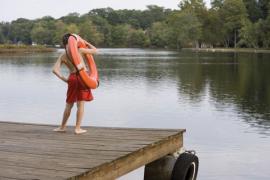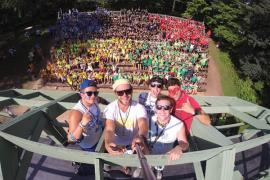With eight years of the Healthy Camps initiative completed, the program recently launched its third phase of inquiry. The focus for 2015–2017 is the mental, emotional, and social health (MESH) aspects of the camp experience for campers and staff. This was selected because:
- The number of campers and staff with MESH concerns and/or diagnoses seems to be growing. While the diagnoses are one thing, the associated behaviors of concern have the potential to impact the camp experience of the person as well as that of others. How might a camp professional assess this risk potential and what options exist for addressing it?
- Camp professionals want to be as inclusive as possible yet also recognize that their camp may not be a good fit for everyone. How does one determine one’s capacity to support campers/staff with behaviors of concern while preserving the essence of what a given camp is all about?
- It is recognized that the camp experience has a positive impact on youth. This includes being good for campers’ mental, emotional, and social health. What is it about camp that impacts the MESH domain and how might camp professionals be more strategic in creating a positive impact?
What’s the Focus of Healthy Camps III?
Given these reasons for selecting MESH as the focus for Healthy Camps III (HC-3), what are the anticipated outcomes for the next couple years? This was the topic of discus-sion for the project’s steering committee, a group of ACA volunteers who convened last March. With support from Markel Insurance, the mission partner for Healthy Camps since its inception, this ACA operational committee was charged with (a) articulating the scope of the committee’s work around the MESH concept, (b) developing an action plan that moves the initiative forward, (c) implementing and evaluating that plan, and (d) keeping previously developed Healthy Camps resources “fresh.”
As might be expected, the MESH topic elicited discussion that was deep and genera-tive. By the end of the two-day meeting, outcome targets began to emerge:
- Get the MESHage out! Raise awareness of the MESH concept within the camp community and other audiences while educating about its importance.
- Create/identify MESH resources that are easy for camp professionals to utilize.
- Provide at least one resource that addresses each of the three presenting questions and, perhaps even more importantly, set the stage for continued work by interest-ed people.
- Make sure all created resources are evidence based, reflect good practice, and are as inclusive as possible.
- Utilize MESH experts as needed to address particular questions and develop resources for the camp community while also informing mental health profes-sionals of camp needs.
Interestingly, very specific questions were identified during the discussion that framed development of these outcomes. For example, at what point does a MESH concern become a problem? Some diagnoses — AD/HD is a great example — may have minimal camp impact because the person uses medication and/or the camp environment minimizes the impact of certain behaviors. But other MESH concerns aren’t as easily managed and/or risk “break through” behaviors. Where is that tipping
point and what options are there for responding? Other concerns coalesced around the difference between camper (client) and staff (employee) parameters. What might camp management need to know about a camper’s MESH manage-ment plan, and what can an employer know about employee plans? Still other questions centered on a camp’s connec-tion with parents (custodial adults). The camp experience is most impactful when participating youth are engaged with it. Some kids have pre-existing MESH tensions that can affect that engagement. What questions should camps be asking parents, and how might camp profes-sionals truly partner with them to (a) get needed information, (b) develop strategies so the child’s experience is beneficial to everyone, and (c) have a response plan when things don’t go as anticipated?
As the committee worked, it became apparent that some MESH components are more easily addressed than others. Creating a chart of medications and list-ing their camp impacts (e.g., medications that are more quickly metabolized when the person gets overheated; medications that decrease appetite) is such an example. So, too, is locating resources that help camp professionals assess suicide inten-tionality — although there’s more to this topic than merely assessing intentionality. And, as might be expected, other areas need discrete discussion and discern-ment. For example, listing the differences between home and camp living that impact a person’s emotional state and influence his or her social interaction has potential to help everyone adjust more effectively to camp life.
The ACA community can look forward to more discussion and probing within a variety of MESH areas over the next two to three years. Indeed, we’re
in need of descriptive data to actually quantify our concerns and help prioritize work efforts. We have lots of stories but very little data. Toward that end, some members of the Association of Camp Nurses (ACN) have agreed to gather basic descriptive data over the summer in a way that protects human subjects. We want to know what diagnoses come attached to campers and staff; this will indicate what behavior strategies to target. We’re interested in what medications are given so the list describing potential interac-tions with camp experiences can be as robust as possible. And without divulging information about specific individuals, we’re interested in probing for differences between camper and staff populations. Such evidence-based information means work effort can be based on reality.
As the committee discussed the MESH topic, one theme surfaced over and over: to make sure resulting tools and resourc-es are usable. Most camp professionals want information that makes their job easier, improves the camp experience for kids, and enhances staff interaction with campers; consequently, the usability of work products is critically important.
What about Earlier Healthy Camps’ Resources?
ACA’s website provides access to the learning tools and resources associated with the Healthy Camps initiative. These can be found by entering “Healthy Camps Toolbox” into the ACA site search box. Information has been developed and updated over the past eight years of the program’s existence. The plan is to maintain that information, add to it as needed, and drop content that becomes dated. Here’s a sample of what you’ll find waiting for you:
- A Healthy Camp Starts at Home: This downloadable PDF tells par-ents what they can do to help their child have a great camp experience. Designed for camp professionals to give parents, the list of suggestions includes reminders (a) to bring healthy children to camp and whom to call if their child is ill on opening day, (b) to teach their child how to effectively cover coughs/sneezes and wash his or her hands before coming to camp, and (c) to inform camp leadership about their child’s mental, emotional, and/or social health needs.
- Webinars on topics such as concus-sion management, injury-illness surveillance, and communicable disease control strategies.
- A list of points to consider when moving toward electronic health recordkeeping in the Health Center.
- Access to The Healthy Camps Impact Report with its summa-tive data and — more impor-tantly — things to do so campers and staff have a safe and healthy camp experience.
How Can You Help Healthy Camps III?
Let the HC-3 committee know about your questions, experiences, and strategies that impact the MESH focus. Committee members are listed in the sidebar along with the names and addresses of a couple people who are willing to systematically collect your information. As you move through the summer, tell us what you’re learning, describe your “pain points,” and share approaches.
Ultimately, we want a successful camp experience for everyone. So along with challenging situations, also think about what’s going right and why that’s happen-ing. Perhaps your cabin counselors de-brief campers during an evening “Cabin Council.” Perhaps you’ve hired a coun-selor who is also a social worker and who strategically works with at-risk campers. Maybe you used to have a problem with a social issue like bullying but, because of something you’ve done, that problem has been mitigated. There’s much to learn. By sharing experiences and examining the “golden nuggets” of information within those experiences, others can also benefit.
There are high hope for success around this MESH initiative. But what does that mean? When we consider
the health of our camp community, it becomes apparent that caring for the physical elements — the scrapes and upset stomachs — is the easy part. Coping with what’s going on in minds, what’s colored by emotion, and what’s influenced by social skills is a more daunting challenge. So, let’s define success in terms of better understanding coupled with more effective coping strat-egies around MESH topics. Then we’ll be making even more progress along our Healthy Camps continuum.
Linda Ebner Erceg, RN, MS, PHN, is the associate director of Health & Risk Management for Concordia Language Villages and executive director of the Association of Camp Nurses in Bemidji, Minnesota.



